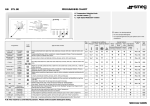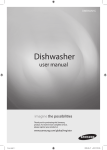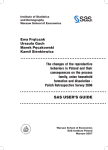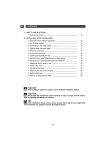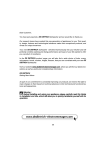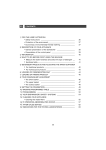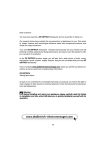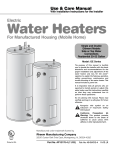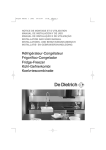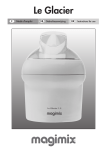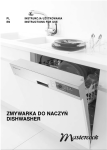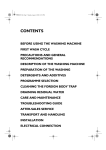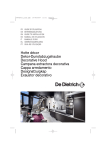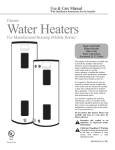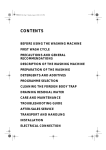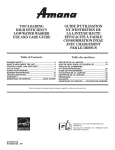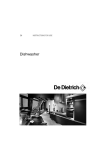Download De Dietrich DVH610JU1 dishwasher
Transcript
EN CONTENTS 1/ FOR THE USER’S ATTENTION • Safety instructions ______________________________________ • Protection of the environment ____________________________ • Economical, environmentally friendly washing ________________ 2/ DESCRIPTION OF YOUR APPLIANCE • General presentation of the dishwasher ____________________ • Presentation of the control panel __________________________ 3/ INFORMATION • The water hardness______________________________________ 4/ ACTIONS BEFORE FIRST USE • Measure the water hardness and select the detergent ________ • Hardness table__________________________________________ 5/ DETERGENT PRODUCTS AND SETTING THE WATER SOFTENER • For traditional products __________________________________ • For multi-purpose products ________________________________ 6/ LOADING THE REGENERATING SALT __________________________ 7/ LOADING THE RINSING PRODUCT ____________________________ 8/ YOUR DISHWASHER’S EQUIPMENT • The lower basket ________________________________________ • The upper basket________________________________________ • The cutlery basket ______________________________________ 9/ THE DISHWASHER’S SAFETY SYSTEMS________________________ 10/ WASHING PROGRAMMES __________________________________ 11/ PROGRAMMING __________________________________________ 12/ CLEANING YOUR APPLIANCE • Cleaning the waste filters ________________________________ 13/ IF OPERATING ANOMALIES OCCUR __________________________ 14/ AFTER-SALES SERVICE ____________________________________ 15/ INDICATIONS FOR THE TESTING LABORATORIES ______________ 31 34 34 35 36 37 38 39 39 40 40 42 43 44 45 46 47 48 50 51 53 58 59 EN 32 Dear Customer, Présentation de votre lave-vaisselle You have just acquired a DE DIETRICH dishwasher and we would like to thank you. Our research teams have created this new generation of appliances for you. Their quality, design, features and technological advances make them exceptional products, and reveal our unique know-how. Your new DE DIETRICH dishwasher will blend harmoniously into your kitchen and will perfectly combine washing and drying performance and ease of use. We wanted to offer you a product of excellence. In the DE DIETRICH product range, you will also find a wide choice of hobs, ovens, microwaves, hoods, cookers, fridges, freezers, that you can coordinate with your new DE DIETRICH dishwasher. Visit our website www.dedietrich-electromenager.com, where you will find our latest innovations as well as useful and complementary information. DE DIETRICH Setting New Values As part of our commitment to constantly improving our products, we reserve the right to make changes to them based on technical advances to their technical and functional features and appearance. Warning : Before installing and using your appliance, please carefully read this Guide to Installation and Use, which will allow you to quickly familiarise yourself with its operation. 33 EN 1/ FOR THE USER’S ATTENTION Important : • Children’s safety Keep this user’s manual with your appliance. If the appliance is sold or transferred to someone else, ensure that the manual is with it. Please take note of these instructions before installing and using your appliance. They have been drawn up for your own and other people’s safety. — This appliance must only be used by adults. Ensure that children do not touch it and do not use it as a toy. Ensure that they do not operate the appliance’s controls. — Keep young children away from the appliance when it is operating. — Detergents contain irritant and abrasive substances. These products can have caustic effects on the eyes, the mouth or the throat. They can be extremely dangerous if ingested. Avoid any contact with the skin and the eyes. Ensure that the appliance’s detergent container is empty at the end of the washing cycle. — Place detergents out of children’s reach and do not put any detergent in the machine until just before you start the washing programme. — The water in your dishwasher is not drinking water; this is why children must not go near the appliance when its door is open. — Do not let your children play or sit on the door when it is open. — Once you have unpacked your appliance, place the packaging out of children’s reach. — Keep all the packaging materials (e.g. plastic bags, polystyrene, etc.) out of children’s reach because they can be dangerous for children: risk of suffocation. • SAFETY INSTRUCTIONS • Installation — When you receive your appliance, unpack it or have it unpacked immediately. Check that it has not suffered any damage during transport. Express any reservations in writing on the delivery note, of which you keep a copy. Never connect up a damaged machine. If your appliance is damaged, please contact your dealer. — Before proceeding to connect up your machine, please refer to the instructions in your Installation Guide. — Your dishwasher must be kept disconnected from the mains supply throughout the whole of the installation process. — The electrical connection details on your appliance’s description plate must comply with those for the mains supply. — The socket must still be accessible once your appliance has been installed. — Do not alter or attempt to alter the appliance’s characteristics. This could put you at risk. — If your installation has to be altered, only entrust the electrical and plumbing work to a qualified electrician or plumber respectively. — Your appliance is designed for normal domestic use. Do not use it for industrial or commercial purposes or for any other purpose than that for which it has been designed. — The dishwasher’s walls must not be pierced under any circumstances. • Use — Only use products specially designed for your dishwasher (water softening salt, detergent and rinsing products). — As far as possible, avoid opening the dishwasher’s door when it is operating, and in particular during the heating phases, because scalding steam may escape or you may be splashed with hot water. The machine is fitted with a safety system that immediately blocks the dishwasher’s operation if the door is opened. 34 EN 1/ FOR THE USER’S ATTENTION — Never use chemical solvents in your appliance because these could cause an explosion. — Always close your appliance’s door after loading or removing your items. — Do not lean or sit on your appliance’s door when it is open. — Once the programme has finished, unplug the appliance and shut off the water tap. — Unplug your machine before carrying out any technical work on it. — Avoid placing your machine immediately next to a cooking or heating appliance to prevent any risk of heat damage; — Do not place any items in your machine, which are not certified as dishwasher safe. — If you have removed an item before the end of the washing programme, it is important to rinse it carefully to remove any residual washing products — If your appliance breaks down, never attempt to repair it yourself. Any repairs made by non-qualified personnel can cause significant damage or lack of control. • ENVIRONMENTAL PROTECTION This appliance’s packaging material is recyclable. Help recycle it and protect the environment by dropping it off in the municipal receptacles provided for this purpose. Your appliance also contains a great amount of recyclable material. It is marked with this label to indicate the used appliances that should not be mixed with other waste. This way, the appliance recycling organised by your manufacturer will be done under the best possible conditions, in compliance with European Directive 2002/96/EC on Waste Electrical and Electronic Equipment. Contact your town hall or your retailer for the used appliance collection points closest to your home. We thank you doing your part to protect the environment. • ECONOMICAL, ENVIRONMENTALLY FRIENDLY WASHING — Remove any food residue from your items (bones, pips, etc.) — Do not pre-wash your items by hand (useless waste of water). — Utilise your dishwasher’s capabilities to the full for an economical, environmentally friendly wash. — Always select a washing programme suitable for the type of items and how dirty they are. — Avoid overdosing with detergent, regenerating salt and rinsing liquid. Follow the recommendations in this guide (pages 41-42-43) and the instructions on the product packs. — Ensure that the water softener is correctly set (see page 40). 35 EN 2/ DESCRIPTION OF YOUR APPLIANCE • GENERAL PRESENTATION OF THE DISHWASHER B C D E F G H I J Fig. 01 A A Control panel F Regenerating salt tank B Upper basket G Waste filter C Washing products dispenser H Main filter D Anti-blocking gauge wire I Rinsing product dispenser E Lower sprinkler arm J Description plate (After-Sales Ref) Advice : This user’s guide is applicable to several models. There may be some slight differences in the details and the equipment between your appliance and the descriptions provided here. 36 EN 2/ DESCRIPTION OF YOUR APPLIANCE • PRESENTATION OF THE CONTROL PANEL C Fig. 02 A B A On/ Off : Press this button to start your dishwasher : the screen lights up. F F Start / C : Briefly press this button to start your programme. If you make an error, to cancel a selection or cancel a programme while it is running, hold down this button for 3 seconds. B Choosing a programme: briefly press one button or the other in succession to select your programme. C D E The indicator lights : Salt: : Intelligent Control System lit; indicates lack of regenerating salt. press this button to select the Automatic programme. Rinsing liquid: lit; indicates lack of rinsing product. D Set : • Set the water softerner. washing product: lit; indicates that your dishwasher is set to use “2, 3 4-in-1” pellets. (See 5/ Detergent products and setting the water softener). • Setting the audible signal. (See 11/ Programming). In progress lit; indicates that your programme is running. E Delayed programme start End : Press this button to delay the programme by 3, 6 or 9 hours. lit; indicates that your programme has finished Advice : A short audible signal (beep) confirm the button’s selection, except for the “On/Off” button. (See 10/ Washing Programmes). 37 EN 3/ INFORMATIONS Important: For impeccable results, preferably use a combination of traditional products: ① Washing detergent to clean the For your dishwasher to provide impeccable washing and drying results with no marks, you must set it correctly using the water softening system, which uses regenerating salt. crockery perfectly (powder, liquid or standard tablets). ② Regenerating salt to enable your dishwasher’s water softener to operate correctly. • THE WATER HARDNESS • Lime: rainwater filtering through the ground picks up mineral salts; some minerals are found in solid form commonly termed lime. This reduces the washing detergent’s performance, furs up the dishwasher and leaves white marks on the crockery. The more lime there is in the water, the more the water is called “hard”. ③ Rinsing liquid to assist drying and to eliminate marks from water droplets. Important: Never use washing-up liquid. Use the most suitable products for the level of water hardness in your town. There are several types of products; how to choose: For ease of use and only in certain water hardness conditions < 35°F, multi-purpose products may make the use of rinsing liquid or salt unnecessary. • “Two-in-one” products contain detergents, rinsing liquid or an agent acting as the salt. • “Three-in-one” products contain detergents, rinsing liquid and an agent acting as the salt. • “Four-in-one” products also contain additives that prevent wear on poor quality glasses and /or prevent the risks of the stainless steel corroding. Important: Follow the instructions for using the multi-purpose product and the recommendations on the pack. NB: If in any doubt, please contact the detergent manufacturer if the crockery is very wet at the end of the programme or if chalky deposits appear. 38 EN 4/ ACTIONS BEFORE FIRST USE • MEASURE THE WATER HARDNESS AND SELECT THE TYPE OF DETERGENT: TRADITIONAL OR MULTI-PURPOSE First of all, in one simple action, you can test the lime content in your water using the testing strip supplied with your dishwasher or you can contact your local water utility to find out how hard your water is. — Turn on the tap and let the water run for a few minutes. — Fill a glass with water. — Take the testing strip out of its casing and immerse it for 3 seconds. — Wait 1 minute, shake the strip and look at the colours to find out how hard your water is. • HARDNESS TABLE Testing strip Hardness Water 0-10°F Soft Softening and use of salt Optional 10-25°F 25-40°F Slightly hard Slightly hard Essential if Essential if using traditio- using traditional products nal products Possible to use traditional products ➊ ➊ or ➋ or + 40-55°F Hard 55-70°F Hard > 70°F Very hard Essential Essential Essential Use of traditional products only ➊ + R or multi-purpose products + ➋ ➊ Traditional products: P : Powder detergent or L: Liquid detergent + S: regenerating Salt + R: Rinsing product ➋ Multi-purpose products: “multi-purpose” tablets. 39 + R EN 5/ DETERGENT PRODUCTS AND SETTING THE WATER SOFTENER • FOR TRADITIONAL PRODUCTS • Your appliance must be specially set to use traditional products. • Proceed as follows to adjust the water softener on the control panel: — Access setting mode by holding down the “Set ” button until you hear a double audible signal (long beep); the indicator lights illuminate (Fig. 02). Fig.02 — Press one button or the other once ; the lights that are lit indicate the setting (factory setting 40 - 55°F). — Briefly press one button or the other in succession to adjust the setting to suit the water hardness. — The setting is validated automatically after 10 seconds if the “Set” button in not pressed again. — Refer to the table below • FOR MULTI-PURPOSE PRODUCTS • Your appliance can be specially set to use multi-purpose if the water hardness is < 25°F. Advice : For better coverage of the variety of multi-purpose products available, your dishwasher’s option has two possible settings • Proceed to set the option, if necessary — Refer to the table below ( light permanently lit or flashing). “Extra Dry” (factory setting) improves drying results in the event of lower performance from the type “2-in-1”, “3-in-1” or “4-in-1” multi-purpose product. “Sparkling Clean” prioritises the brilliance of your items, whatever the type of multi-purpose product used. Testing strip Hardness Softener setting Traditional products Multi-purpose products “Extra Dry” (factory setting) 0 - 10°F “Sparkling Clean” “Extra Dry” (factory setting) 10 - 25°F “Sparkling Clean” 25 - 40°F 40 - 55°F 55 - 70°F > 70°F Light unlit: Light permanently lit : light flashing : 40 EN 5/ DETERGENT PRODUCTS AND SETTING THE WATER SOFTENER Important: It is very important to set your water softener correctly. - If the setting is too low, there is a risk of chalky marks - If the setting is too high, there is the risk of the glasses becoming cloudy If you move house, re-adjust the setting on your water softener. • Traditional tablets Place tablets that are not multi-purpose in the external compartment (Fig 04) or, for optimum operation, pull out the distributor’s drawer and lay the tablet there. (Fig 05) • Powder or liquid in the distributor’s drawer (Fig 03) Fill at least up to the minimum mark for slightly dirty crockery and up to the maximum mark for dirty crockery. If the crockery is very dirty or for programmes with pre-wash, we recommend that you add 5g of detergent (a dessertspoonful) to the tub in accordance with the programmes table. Important: Keep these products in a dry place, out of children’s reach. Only use products specially designed for dishwashers. Fig. 03 Fig. 04 Fig. 05 Important : The multi-purpose products setting enables you to de-activate the rinsing products and salt warning lights only on the hardness setting from 0 to 10°F. • Loading multi-purpose tablets To make loading the detergent easier, the distributor is located on the front of the upper basket; it is compatible with all the products recommended for your dishwasher. • Place the tablet in the external compartment (Fig 04 on previous page) or or, for optimum operation, pull out the distributor’s drawer and lay the tablet there. (Fig 05 on previous page). - Close the distributor. 41 EN 6/ LOADING THE REGENERATING SALT • Loading the regenerating salt (Fig. 06) Important : Only use special dishwasher regenerating salt. Do not use table salt or any type of cooking salt: this could damage your appliance’s water softener. A SE L A Unscrew and remove the stopper on the salt tank. B Fill the tank with regenerating salt specially designed for dishwashers. C Use the funnel supplied with your dishwasher. The first time, top up with water up to the rim of the tank. B EAU • Regenerating salt indicator : This illuminates when salt must be added. After the tank has been filled with regenerating salt, the indicator light may remain lit until the salt has dissolved sufficiently, usually after one cycle (of if the tank has not been filled completely; for example, when first putting the machine into service using the sample). This can be deactivated as indicated in the paragraph “For multi-purpose products” setting table. C Fig. 06 Important : If the salt overflows when filling the tank, to avoid oxidization of the tub it is advisable to remove the salt crystals or to run a Soaking programme. 42 EN 7/ LOADING THE RINSING PRODUCT • The rinsing product (Fig. 07) Important: Use a special dishwasher rinsing product; this will give you dry, sparkling crockery. A A B Before switching on the appliance, fill the rinsing product container until the level is flush with the top of the setting lever. Adjust, if necessary; the original setting is 2. If you experience poor drying or residual marks after a few cycles, increase the setting by turning the lever (fig 07 C : marking 3 to increase it) • Checking the level of rinsing liquid : This lights when rinsing liquid must be added. It can be deactivated as shown in the paragraph “For multi-purpose products” setting table. 3 12 B Important: If any rinsing liquid overflows onto the door when filling the container, sponge away the excess to avoid foam forming. 3 12 C Fig. 07 43 Adjustment lever EN 8/ YOUR DISHWASHER’S EQUIPMENT Very important : Items not suitable for washing in a dishwasher - Wooden cutting boards, - Stainless steel utensils or plastic utensils that are not heat-resistant, - Copper or pewter items, - Glued crockery and cutlery, - Cutlery with wooden, horn or mother-of-pearl handles, - Antique or hand-painted porcelain. When purchasing crockery, glasses or cutlery, ensure that it is dishwasher-safe. • THE LOWER BASKET Arrange your items so that the water can circulate freely and spray over all the utensils. Place large diameter dishes and pans at the sides. Do not intersperse, jam together or superimpose flat plates and concave dishes (Fig. 08). The folding spikes make it easier to arrange your large dishes (Fig. 09) (depending on the model). Advice : When you re-insert the lower basket, ensure that nothing catches on the upper basket’s gauge wire to avoid blocking the rotor. Fig. 08 Unloading your items First of all empty the lower basket to avoid drips from the upper basket falling onto the lower basket. Fig. 09 44 EN 8/ YOUR DISHWASHER’S EQUIPMENT • THE UPPER BASKET This basket is particularly designed to take: glasses, cups, ramekins, small salad bowls, bowls, saucers, etc... Arrange your items methodically to save on space (arranging glasses, cups or bowls together, etc.) You can also arrange cups, ladles, etc. on the retractable supports (Fig. 10) Advice : Position the cavities of glasses, cups or bowls facing downwards. Cutlery basket Fig. 10 • Adjusting the height of the upper basket (depending on the model) For large dishes to be loaded in the lower basket, the upper basket must be set in to high position. This can be done with the basket fully loaded (Fig. 11) ① Setting in HIGH POSITION : Gently raise your basket on each side until it engages. Fig. 11 ② Setting in LOW POSITION : Raise your basket completely on both sides to unlock it and then lower it to the low position. Important : Check that the two slides are set to the same height and the basket is horizontal. 45 EN 8/ YOUR DISHWASHER’S EQUIPMENT • THE CUTLERY BASKET The cutlery basket slides to allow for modulable loading. It can be placed anywhere in the lower basket. You can therefore make a variety of loads depending on the items (Fig. 12). If your cutlery items or your dishes are too large, alter the height setting for the upper basket (if it can be adjusted, depending on the model). Fig. 12 Movable grills are available for if you wish to load your cutlery in an orderly manner (Fig. 13). For optimum washing and drying, use these separation grills partially or totally. Point the handles on the cutlery downwards. Important : For safety reasons, we recommend that you place knives with pointed ends with the point facing downwards in the cutlery basket (to avoid the risk of an accident). Long-bladed knives and other sharp kitchen utensils must be placed flat in the upper basket. Fig. 13 Avoid washing cutlery with horn handles in your dishwasher. Separate silverware from other metals using the separation grill. 46 EN 9/ THE DISHWASHER’S SAFETY SYSTEMS • Door not closed properly The light flashes when the door is open or not closed properly. • Anti-overflow system This system automatically activates the drain pump if the water level in the tub reaches an abnormal height. • Anti-leak system This system interrupts the water supply if a leak is detected under the appliance. • If an anomaly occurs the “End” light flashes rapidly. The four lights indicate the anomaly as per the table on page 53. 47 EN 10/ WASHING PROGRAMMES • PROGRAMMES TABLE Type of items: - porcelain, pans, cutlery, glasses, etc. Quantity, type and amount of food residue. Programmes Programme sequence Resistant Mixed Mixed Very dirty large dishes and pans, with baked on residue, grease, cooked cheese, sauce, etc. Normally dirty, i.e. a normal amount of sticky and greasy residue. Normally dirty, i.e. a normal amount of sticky and greasy residue. A longer programme because it saves on energy. Intensiv Normal Hot pre-wash Pre-wash Pre-wash Washing at 70°C Washing at 65°C Washing at 55°C Rinse Rinse Rinse Hot rinse Hot rinse Hot rinse As an indication only: Drying by condenser Drying by condenser Drying by condenser Duration in min Water (L) Energy (Kwh) 115’ 17 1,7 90’ 17 1,5 130’ 17 1,3 These values refer to normal conditions of use with separate products (detergent, salt, rinsing product).They may vary depending on the load, the temperature, the water hardness, the use of multi-purpose products or the supply voltage.. 48 EN 10/ WASHING PROGRAMMES Mixed Mixed Mixed Mixed Normally dirty Washing at low temperature, economical and particularly suitable for compact – enzymatic detergents Very short 30minute wash specially designed for a small amount of daily items with a limited amount of non-greasy residue, not dried on Very short cycle (with no detergent) for rinsing and re-dampening the items while waiting for a wash expected the following day or even the day after Intelligent Control System Rapid Automatic detection of the amount of residue. Optimises the results and prioritises energy savings. Soak Pre-wash Pre-wash Washing at 50°C Washing at 45°C Washing at 55/65°C Rinse Rinse Rinse Hot rinse Hot rinse 60°C Hot rinse Drying by condenser Short drying cycle, not fan assisted Drying by condenser 170’ 16 1,05 30’ 11 0,8 15’ 4,5 0,02 49 90’ - 110’ 17 - 19 1,3 - 1,5 EN 11/ PROGRAMMING C Fig. 02 A B D E F Advice : Consult the Programmes table on the preceding pages to determine the programme you need for the type of items, the quantity and the amount of food residue. • Immediate programme start • End of the programme On /Off” A , to switch on your Press “O appliance and select your programme by pressing one button or the other or the Automatic programme by pressing the ICS button. The light flashes 15 minutes before the end of the programme and then lights permanents once the programme has finished. • Setting the audible signal The setting enables you to activate or de-activate the beep at the end of the programme. — Access the setting by holding down “Set” juntil you hear a double audible signal (long beep). Select your preference by pressing the “Delayed Start” button E : - Beep activated : an audible signal is heard and the “End” light flashes. - Beep de-activated : no audible signal and the “End” light is unlit. The setting is confirmed automatically after approximately 10 seconds. — When a programme is selected, the associated light illuminates. Press “Start/C” F , the “In progress” light illuminates. Close the door and the programme starts. A short audible signal (beep) confirm the button’s selection, except for the “On/Off” button. • Delayed programme start After selecting your programme, press the “Delayed Start” E button once twice or three times depending on whether you wish to delay the programme start by 3, 6 or 9 hours; the appropriate light illuminates. Confirm by pressing “Start/C”. • Cancelling a programme C” F button for a few Hold down the “Start/C seconds. 50 EN 12/ CLEANING YOUR APPLIANCE • CLEANING THE WASTE FILTERS ➀ The filtration system consists of several elements: A - The waste filter. B - The large main filter. C - The micro filter. B A ➁ The filters are located in the centre of the tub and must be washed regularly to obtain opti mum washing results. • Actions : ➀ A Before removing the filters, remove any waste on the large main filter B with a sponge so that the waste does not block the sprinkler arms. Orient the rotor as shown in the drawing. (Fig. 14) ➁ Loosen the waste filter a quarter of a turn and then remove it A . ③ Remove the main filter B . ④ Remove the micro filter screen ⑤ Carefully clean filters A C ③ B C . ④ , B and C C Fig. 14 ⑤ under running water. (Fig. 15) Reinstallation: Proceed in reverse order, inserting filters C and B and then A . A Fig. 15 Important : Remember to lock the waste filter in A place by pushing it in fully and turning it a quarter turn. 51 B C EN 12/ CLEANING YOUR APPLIANCE • Periodically : Every 3 or 4 months, in order to remove any deposits, run a special maintenance programme, without any items in the machine, using a commercially available special dishwasher cleaning product. Important : Keep this product out of children’s reach.. • Prolonged stoppage Clean your dishwasher completely and then unplug it from the electricity supply and close the water tap. Protect your machine from potential frosts Advice : Do not use abrasive powders, metal sponges and alcohol-based or thinner-based products. Use a cloth or a sponge. If you are moving house, run a soaking programme first of all, in order to avoid any water escaping. • Cleaning and upkeep of your appliance To keep your appliance in good working order, we recommend that you use Clearit household products. Professional expertise for the general public Clearit offers you professional products and adapted solutions for the daily upkeep of your household and kitchen appliances. You may find them in conventional retail outlets, along with a complete line of by-products and consumables. 52 EN 13/ IF OPERATING ANOMALIES OCCUR • SUMMARY OF THE FAULTS Flashing LED(s) for models without a display Flashing LED(s) ➊ d01 : water supply fault (tap) d07 : overflow / anti-leak fault ➊ d02 : draining fault d08 : sprinkling distribution fault ➑ ➊ d03 : heating fault d11 : pressure sensor fault ➊➑ d04 : temperature fault d12 : filling fault (water inlet detection system) ➑ ➊ d05 : fault – motor under load d13 : overheating fault ➊➑ d06 : fault - motor overload d14 : pump filling fault ➑ • WHEN FIRST PUTTING INTO SERVICE Problem Possible Causes What to do ? The door falls heavily when - Door springs not tensioned - Tighten the two tensioning opened (integratable model) enough to compensate for the screws accessible in the botweight of the panel. tom section above the front feet. The door does not stay horizontal - Door springs tensioned too - Loosen the two tensioning when open or returns too quickly much. screws accessible in the bot(integratable model) tom section above the front feet - Fit a wooden panel on the - No wooden panel. appliance (chipboard panel in temporary) and adjust the springs. The door catches when closing - Appliance not stable - Adjust the feet. - Door not centred on the tub - Re-centre by adjusting the rear feet. The upper basket does not stay - Poor manipulation (the basket - Act more progressively (see in the high position is being pulled upwards too instructions), one side and quickly) then the other. Small leak around or under the - Leak from the tap. appliance (move the appliance - Leak from the appliance. to locate the leak better) (Cf. table fault d07). Small leak at the door - Check that a seal is fitted and retighten the nut. - Close the water tap and call a technician. - Appliance not stable or not level - Adjust the feet. - Door not centred on the tub. - Re-centre by adjusting the rear feet. 53 EN 13/ IF OPERATING ANOMALIES OCCUR • THE INDICATOR LIGHTS Problem The salt light does not go out Possible Causes What to do ? - No salt or an insufficient quan- - Refill the tank and wait for the tity of salt in the tank to trigger cycle to end. If you have soft the float. water that requires no salt, the light is constantly lit. The lights all light up one after - Wrong programme. the other - Cancel the current programming by holding down the Start button for 3 seconds and then re-programme. A light flashes and the programme does not start - Reposition the selector on a programme. - Programme selector wrongly positioned (between two notches) • RELATING TO PROGRAMMING, DISPLAY Problem The cycle lasts too long Possible Causes What to do ? - lThe energy-saving programmes last longer because the agitation and drying times are longer to compensate for the lower washing and drying temperatures - Use these programmes preferably at night when it is not so important how long the programme lasts or when it ends. The appliance trips the circuit - Insufficient amperage to sup- - Check the socket’s amperage breaker (10A minimum) and the ply all the appliances being meter’s capacity. operated simultaneously. - Internal fault in the appliance. - Call a technician. The appliance does not start - No mains power to the socket. - Check the socket and the fuse - Tap closed. (Cf. table fault d01). - Check the tap is open. - Check the hose line is OK. - Selection error or programme - Cancel by holding down Start lock. for 3” and re-programme. - Start button pressed too long - Just press Start briefly to start (>2”). the programme. - Appliance in Safety mode (anti- Call a technician. leak).(Cf. table fault d07). 54 EN 13/ IF OPERATING ANOMALIES OCCUR Problem Possible Causes What to do ? The appliance will not restart - Door opened during a washing cycle. - Wait for the time delay for resuming the cycle to end (controlled internally by the appliance). The appliance does not drain (Cf. table fault d02). - The cover has not been removed from the sink’s Ubend. - Drain hose kinked. - Remove the cover. - Filters totally blocked. - Pump blocked. - Check the drain hose line behind the machine is OK. - Remove and clean the filters and the drain. - Initiate a Soaking programme If the fault persists, call a technician. • POOR WASHING RESULTS Problem Possible Causes Food traces, deposits, “sand - Items poorly arranged (masgrains” in the glasses ked by another larger item or situated underneath it, items nested or jammed together). What to do ? - Arrange the items properly. Use the most appropriate areas and accessories for each type of item (see instructions). - Upper rotor blocked by cutlery - Check that the rotor rotates or a dish etc. freely (gauge wire). Set the basket in the high position if necessary. - Filter poorly locked and lifting during washing. - Micro filter screen clogged. Traces of grease - Check the filter’s facing and that the filter is locked in place (push it in fully, turning it to the right). - Remove all, the filters and clean them (in warm water), including the micro filter’s screen (once a month). - One or more holes in the rotor - Remove the rotor by turning the lever a quarter of a turn and blocked. clean it under the tap (do not use any tool that could damage the holes). Re-install the rotor. - Detergent dose too low; ineffi- - Increase the dose ; try another cient detergent ; stale product. detergent. - Inappropriate programme - Select a programme with a (temperature too low; duration higher temperature. too short). 55 EN 13/ IF OPERATING ANOMALIES OCCUR • POOR WASHING RESULTS... White marks (identify what type) - Chalky film (removable with - Check that there is salt in the vinegar). tank (light unlit = OK). - Check the water hardness at the tap and that the water softener is set correctly. Adjust it to a higher level if necessary. - Water too hard for using a “4in-1” detergent without the - Traces of salt (items have a addition of salt. - Check that the stopper on the salty taste). salt container is closed correctly. White marks (identify what type) - Glass cloudy because water - Check the water hardness at too soft (cannot be removed). the tap and that the water softener is set correctly. Some detergents in pellet form are more aggressive to glasses and decorations (change the product and use a protective product if necessary). Coloured marks (tea, wine, cof- - Items poorly arranged - Turn the cavities in the items fee) - Detergent dose too low ; inef- towards the jets. ficient detergent - Increase the dose; try another - Programme temperature too detergent. low. - Select a more suitable programme with a higher temperature. - If you use a multifunction - Use the “4-in-1” option. product. (depending on the model). Streaks or dried droplets on - Lack or insufficient amount of - Check the indicator light and glasses rinsing product. fill the tank completely. Adjust the dispensing unit to a higher position if necessary. - Rinsing product out-of-date or - Use a recent product (a good inefficient. product dilutes easily and foams in cold water). - If you use a multifunction - Use the “4-in-1” option with a product. setting prioritizing drying (parametering from the menu depending on the model). Dried-on marks on glasses, - If you use a multifunction - Use the “4-in-1” option with a dullness setting prioritizing brilliance product. (parametering from the menu depending on the model). 56 EN 13/ IF OPERATING ANOMALIES OCCUR • POOR OPERATION Problem Possible Causes What to do ? Constant filling - (Cf. table fault d12). Drain hole - Drain wand fallen on the floor. situated too low for the appliance. A lot of waste on the large filter - The filters and drain outlets are - Remove and clean the filters blocked with too much and the bottom of the drain at the end of the cycle. residue. outlets. Remove large residue from the plates before putting them in the machine. Traces of rust on stainless steel - Quality of the stainless steel - Use “special dishwasher-safe” not dishwasher-safe (knives in cutlery. - Check that the stopper on the particular) salt container is closed correctly. • POOR DRYING RESULTS Problem Possible Causes What to do? A lot of droplets on the glasses. - Lack or insufficient amount of - Check the indicator light and rinsing product. fill the tank completely. - The dose has not been distrib- - If the tank is not empty after uted. approximately 60 washings, call a technician. - Positioning of the items. - To alleviate the phenomenon, arrange the items to restrict water retention as much as possible. Leave the door ajar for a few minutes, if possible Droplets on plastic items, Tefal - These insulating items have a - Arrange them preferably in the coatings, etc. low calorific mass. upper basket. Poorer drying on rapid programmes - On rapid programmes, the drying - Select a rapid programme temperature and drying period are carefully or leave the door ajar reduced to cut down the duration for a few minutes. of the cycle as much as possible. Condensation on the wall of the - Condensation may form on the inside door or the tub. walls, particularly after the appliance has cooled down (sound insulation increases the phenomenon) 57 EN 14/ AFTER-SALES SERVICE • INTERVENTION WORK Any intervention work on your appliance must be performed by a qualified professional approved by the manufacturer. When you call, please mention the full reference for your appliance (model, type and serial number). This information is shown on the description plate (see Fig. 16) ORIGINAL PARTS When maintenance is being carried out, ask for only certified original spare parts to be used. Fig. 16 58 EN 15/ INDICATIONS FOR THE TESTING LABORATORIES • Details common to all models — Washing capacity - - - - - - - - - - - - - - - - - - - - - - - - - - - - - - - - - - - 12 standard place settings — Arrangement of the items - - - - - - - - - - - - - - - - - - - - - - - - - - - - Figs. A-B-C; see next page — Loading as per the indications on next page, without side shelves or stemmed glass support, and 5 cup/saucer supports (4 for12 saucers & 1 for 2 cups) — Setting for upper basket - - - - - - - - - - - - - - - - - - - - - - - - - - - - - Low position — Setting for rinsing product distributor - - - - - - - - - - - - - - - - - - 3 — The water softener must be adjusted in accordance with the instructions in the paragraph on “Adjusting the water softener”. For detailed information on the comparison tests regarding the level of soiling, the types of crockery and cutlery, etc., contact the equipment manufacturer before commencing the tests. • Tests to Standard EN 50242: — Recommended programme - - - - - - - - - - - - - - - - - - - - - - - - - - — Dosage of detergent - - - - - - - - - - - - - - - - - - - - - - - - - - - - - - - - - 30g of detergent B • Tests according to the mixed IEC 436/DIN 44990) method — Recommended programme - - - - - - - - - - - - - - - - - - - - - - - - - - — Dosage of detergent - - - - - - - - - - - - - - - - - - - - - - - - - - - - - - - - - “Eco” 5 + 25g of detergent B NB: When conducting tests using a multi-function tablet: - Check that the water softener is correctly set for the water hardness — Pull out the detergent distribution drawer and place the tablet in the interior compartment. — Select the “4/1” option on the control panel. • Measuring the noise level in accordance with Standard EN60704-2-3: — Align the plinth on the housing unit with the door panel. 59 EN 15/ INDICATIONS FOR THE TESTING LABORATORIES A B 1 NOK NOK 2 3 4 OK 5 6 7 8 3 32 60 8 8 8 8 8 8 1 1 1 1 1 1 33 3333 2 33 3 222 1 8 8 8 6 6 8 8 8 5 444 3 4 4 4 44 4 11 C 7 2 2 2 2 2 111 22 444 EN 61 EN 62 EN 63 FR Service après vente : Les éventuelles interventions sur votre appareil doivent être effectuées : - soit par votre revendeur, - soit par un autre professionnel qualifié dépositaire de la marque. Lors de votre appel, mentionnez la référence complète de votre appareil (modèle, type et numéro de série). Ces renseignements figurent sur la plaque signalétique fixée sur votre appareil. DE Kundendienst : Eingriffe an Ihrem Gerät dürfen nur: - von Ihrem Händler oder - von einem sonstigen Fachmann und Vertragshändler der Marke durchgeführt werden. Geben Sie bei der Meldung einer Störung die vollständige Typenbezeichnung Ihres Gerätes an (Modell, Typ, Seriennummer). Diese Angaben finden Sie auf einem an Ihrem Gerät angebrachten Schild. ES Servicio postventa : Las intervenciones que requiera la máquina deberán ser efectuadas: - por el revendedor, - o por cualquier profesional cualificado depositario de la marca. Al llamar, mencione la referencia completa de la máquina (modelo, tipo y número de serie). Estos datos figuran en la placa de identificación situada en la máquina. PT Serviços autorizados : Qualquer intervenção no seu aparelho deve ser realizada: - quer pelo seu revendedor, - quer por outro profissional qualificado autorizado pela marca. Ao chamá los, indique a referência completa do seu aparelho (modelo, tipo e número de série). Estas informações figuram na placa de identificação fixada no aparelho. DA Kundeservice : NL Serviceafdeling: De eventuele ingrepen in de machine moeten worden uitgevoerd : - of door uw vakhandelaar, - of door een andere gekwalificeerd technicus van dit merk. Tijdens het telefoneren, dient u de complete referentie op te geven van uw machine (model, type, serienummer). Deze informatie staat op het typeplaatje op de machine. PL Usługi serwisowe : Wszelkie czynności serwisowe wykonywane na urządzeniu muszą być wykonane przez: - sprzedawcę, - wyspecjalizowany zakład naprawczy posiadający atest producenta. Aby przyspieszyć i ułatwić obsługę prosimy o podanie dokładnych danych dotyczących urządzenia (model, typ, numer seryjny). Wszystkie te dane znajdują się na tabliczce znamionowej umieszczonej na urządzeniu. CS Záruční servis: Případné opravy na přístroji může provádět pouze : - váš prodejce - nebo záruční opravna, která má smlouvu s výrobcem Při telefonickém styku uvádějte úplné označení vašeho přístroje (model, typ a výrobní číslo). Tyto údaje jsou uvedeny na výrobním štítku přístroje. RU Cepcoe ocyae: , : - , ; - , . ( , ). ! ", . EL Tεχνική υποστήριξη: Οι ενδεχόμενες επεμβάσεις πάνω στη συσκευή σας θα πρέπει να διενεργούνται: - είτε από τον προμηθευτή σας, - είτε από το κατά τόπους εξουσιοδοτημένο σέρβις. Σε περίπτωση που τηλεφωνήσετε, θα πρέπει να αναφέρετε όλα τα στοιχεία της συσκευής σας (μοντέλο, τύπο και αριθμό σειράς).Τα στοιχεία αυτά αναγράφονται στην ετικέτα των χαρακτηριστικών του κατασκευαστή που βρίσκεται πάνω στη συσκευή. Eventuel vedligeholdelse af apparatet skal foretages: - enten af Deres forhandler, - eller af en kvalificeret fagmand, som er anerkendt til dette mærke. Når De ringer op, skal De angive apparatets fulde reference (model, type, serienummer). Disse oplysninger står på typeskiltet, der sidder på apparatet. Photographie de couverture/front cover photography: Michel Gibert B3139-B-1/3-09/06 After Sales Service: Brandt Appliances - SAS au capital de 10.000.000 euros - RCS Nanterre 440 302 347 EN Any maintenance on your equipment should be undertaken by: - either your dealer, - or another qualified mechanic who is an authorized agent for the brand appliances. When making an appointment, state the full reference of your equipment (model, type and serial number). This information appears on the manufacturer's nameplate attached to your equipment.


































